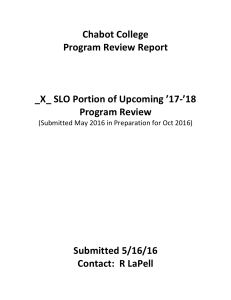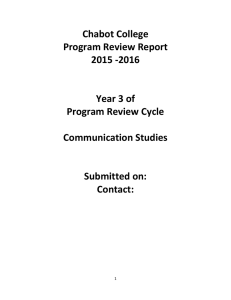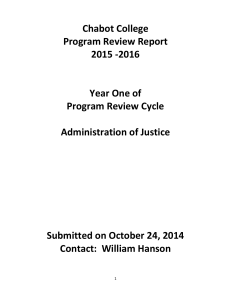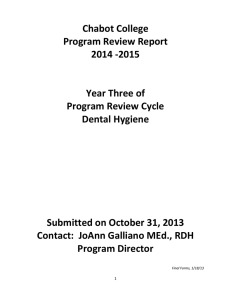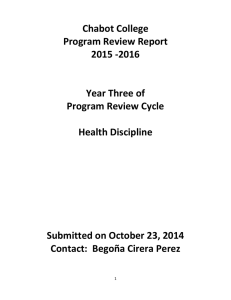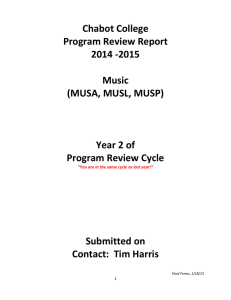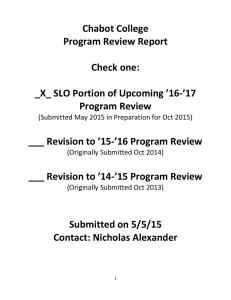Chabot College Academic Program Review Report Year Three of
advertisement
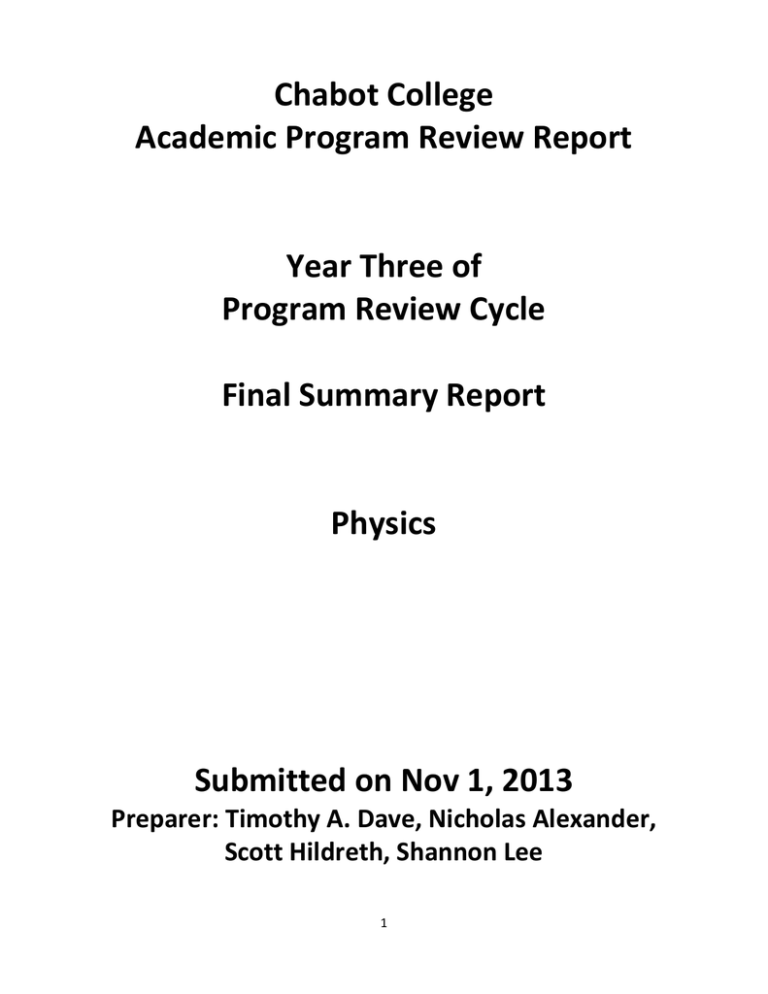
Chabot College Academic Program Review Report Year Three of Program Review Cycle Final Summary Report Physics Submitted on Nov 1, 2013 Preparer: Timothy A. Dave, Nicholas Alexander, Scott Hildreth, Shannon Lee 1 Appendix B2: “Closing the Loop” Assessment Reflections Course Semester assessment data gathered Number of sections offered in the semester Number of sections assessed Percentage of sections assessed Semester held “Closing the Loop” discussion Faculty members involved in “Closing the Loop” discussion Physics 4C Spring 2012 2 2 100% Fall 2012 Timothy Dave, Nicholas Alexander, Shannon Lee, Scott Hildreth Form Instructions: Part I: CLO Data Reporting. For each CLO, obtain Class Achievement data in aggregate for all sections assessed in eLumen. Part II: CLO Reflections. Based on student success reported in Part I, reflect on the individual CLO. Part III: Course Reflection. In reviewing all the CLOs and your findings, reflect on the course as a whole. PART I: COURSE‐LEVEL OUTCOMES – DATA RESULTS CONSIDER THE COURSE‐LEVEL OUTCOMES INDIVIDUALLY (THE NUMBER OF CLOS WILL DIFFER BY COURSE) (CLO) 1: Demonstrate knowledge of applied physics through research papers, projects, labs and/or assignments (CLO) 2: An ability to identify, formulate, and solve applied physics problems. Defined Target Scores* (CLO Goal) 50% score 3 or 4 Actual Scores** (eLumen data) 75% score 3 or 4 50% score 3 or 4 75% score 3 or 4 If more CLOs are listed for the course, add another row to the table. * Defined Target Scores: What scores in eLumen from your students would indicate success for this CLO? (Example: 75% of the class scored either 3 or 4) **Actual scores: What is the actual percent of students that meet defined target based on the eLumen data collected in this assessment cycle? 2 PART II: COURSE‐ LEVEL OUTCOME REFLECTIONS A. COURSE‐LEVEL OUTCOME (CLO) 1: 1. How do your current scores match with your above target for student success in this course level outcome? We are above the target goal for students demonstrating an understanding of precision and accuracy, based on this CLO and when it is assessed in the class. 2. Reflection: Based on the data gathered, and considering your teaching experiences and your discussions with other faculty, what reflections and insights do you have? We will continue to stress the the need for students to demonstrate knowledge of applied physics through research papers, projects, labs and/or assignments B. COURSE‐LEVEL OUTCOME (CLO) 2: 1. How do your current scores match with your above target for student success in this course level outcome? We are above the target goal for students demonstrating an understanding of precision and accuracy, based on this CLO and when it is assessed in the class. 2. Reflection: Based on the data gathered, and considering your teaching experiences and your discussions with other faculty, what reflections and insights do you have? We will continue to stress the need for students to identify, formulate and solve applied physics problems. 3 PART III: COURSE REFLECTIONS AND FUTURE PLANS 1. What changes were made to your course based on the previous assessment cycle, the prior Closing the Loop reflections and other faculty discussions? 1. Physics education researchers determined that the traditional lecture‐based physics course where students sit and passively absorb information is not an effective way for students to learn. A lot of students can repeat the laws of physics and even solve complex problems, but many are doing it through rote memorization. Most students who complete a standard physics class never understand what the laws of physics mean, or how to apply them to real‐world situations. As an effort to determine effective modalities using a “flipped classroom” have been instituted in one two Physics sections as an opening study. The tenets that drive The Flipped Classroom Model are: • The learners need to be personally connected to the topic. Student engagement is the key to learning. This is more likely to occur through engaging experiential activities. • Informal learning today is connected, instantaneous, and personalized. Students should have similar experiences in their more formal learning environments. • Almost all content‐related knowledge can be found online through videos, podcasts, and online interactives, and is more often better conveyed through these media than by classroom teachers. • Learning institutions are no longer the gatekeepers to information. Anyone with connections to the internet has access to high level, credible content. • Lectures in any form, face‐to‐face, videos, transcribed, or podcasts, should support learning not drive it nor be central to it. 2. We modified CLO’s to make more workable with the eLumen system. 2. Based on the current assessment and reflections, what course‐level and programmatic strengths have the assessment reflections revealed? What actions has your discipline determined might be taken as a result of your reflections, discussions, and insights? We are in the process of assessment of a “flipped classroom environment”. And when coupled with our physical learning environment in the form of building 1800 with our physics tutorial center and reconfigurable labs, we are encouraged like Dr.Eric Mazur, Professor of Physics at Harvard…” “I think the answer to this challenge is to rethink the nature of the college course, to consider it as a different kind of animal these days….A 4 course can be a communication across time about a discrete topic, with a different temporal existence than the old doing‐the‐homework‐for‐the‐lecture routine. Students now tap into a course through different media; they may download materials via its website, and even access a faculty member’s interests and bio. It’s a different kind of communication between faculty and students. “ 3. What is the nature of the planned actions (please check all that apply)? X curricular Pedagogical X Resource based X Change to CLO or rubric X Change to assessment methods Other:_________________________________________________________________ Future Plans: As it stands our current Physics 2A/2B, does not meet the needs of schools like UCB for our Bio/life science majors. They require a general physics course that is higher than Physics 2A/B but lower than 4A/4B/4C. But since they only articulate as series, our Bio/Life science students are required to do 3 classes when they really need only 2. This is an issue for Architecture students as well with the need to cross over between the two series, 2A/2B vs 4A/B/C. The 2A/2B is actually limiting our student choices OR creating additional courses for them to take on their path to transfer. Therefore we have created a new curriculum and have submitted it to the curriculum for approval, for a replacement course Physics 3A and #B. This new curriculum if approved and articulated will offer our students a more comparable path to completing the required physics courses (physics 8A/8B at UCB) for transfer in bio/life science. Hopefully for architecture it will require one path for physics completion to all of your schools so that students do not have to manage switching between the Physics 2A/B 5 path and physics 4A to complete their required courses....hopefully they will just have to do Physics 3A or Physics 3A/B. Please note that we will not offer these courses unless they are articulated with all of the schools and make the pathway easier for the students. 6 Appendix C: Program Learning Outcomes Considering your feedback, findings, and/or information that has arisen from the course level discussions, please reflect on each of your Program Level Outcomes. Program: _Physics though at the moment there is no major. However, an effort is proceeding forward to restore the Physics Major at Chabot College. PLO #1: Students will cultivate the ability to apply knowledge of physics to current real‐world applications. (Physics 4ABC) [More specifically as an outcome: Demonstrate knowledge of applied physics through research papers, projects, labs and/or assignments. PLO #2: Students will cultivate the ability to identify, formulate, and solve applied physics problems. (Physics 2AB) [More specifically as an outcome: Demonstrate an ability to identify, formulate, and solve applied physics problems. What questions or investigations arose as a result of these reflections or discussions? We are investigating how to use multi‐media resources and online course tools to address these PLOs. One faculty member is “flipping” the classroom with extensive video clips made available outside of lecture, delivered through a new online tool. One faculty member is utilizing an online homework/media tool with lined YouTube clips to encourage student application and extension. What program‐level strengths have the assessment reflections revealed? Now that we have two innovative and almost fully functional technology enabled learning environments in the form of our labs and student tutorial center in building 1800, it now remains to exploit this critical tools to enhance the learning process in Physics and Astronomy. What actions has your discipline determined might be taken to enhance the learning of students completing your program? To initiate greater Collaborative learning—students working during class in small groups with shared laptop computers and provide Media‐rich visualizations and simulations delivered via laptops, iPads and the Internet 7
